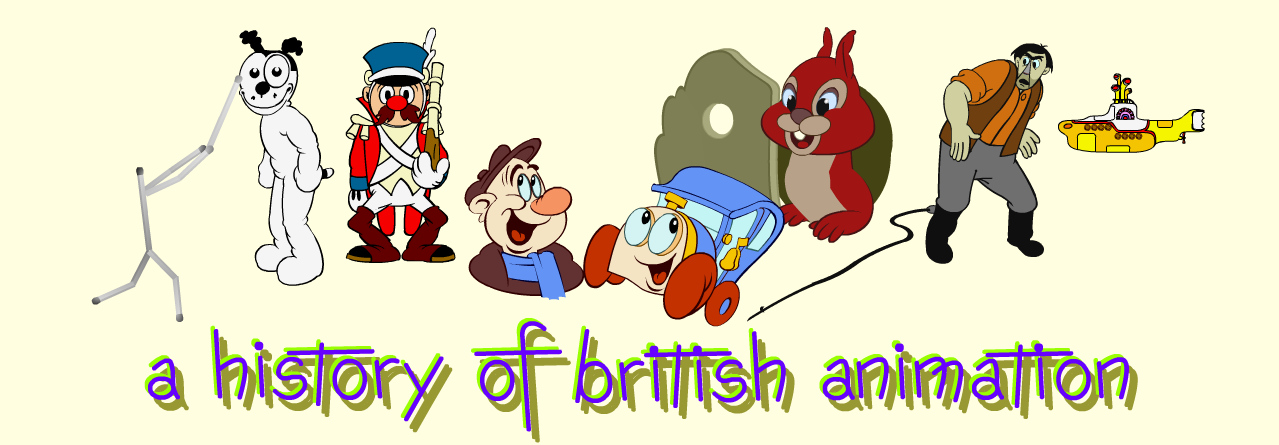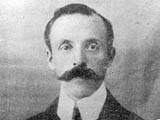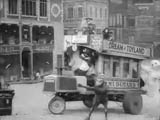

|
 | Arthur Melbourne-Cooper(1874-1961) |  |
||
|
Frederick Arthur Melbourne Cooper was born in St Albans, Hertfordshire on 15 April, 1874, son of photographer Thomas Milburn Cooper and his second wife, Catherine. Learning photography in his father's business, at the age of 18 Arthur Cooper got a job as an assistant to Birt Acres, a photographer experimenting with the photographing and projecting of sequential slides. Acres went on to develope the first British motion picture camera, initially using 70mm film, but later adapted to 35mm film, compatible with Edison's Kinetoscopes. Acres considered the camera a scientific instrument for serious use, and recorded phenomena such as the movement of clouds, along with historical events. Cooper, however, saw the potential for entertainment, and experimented with trick effects and story films. The Cinematograph Syndicate CompanyIn these early days prints were sold to owners of projectors, many of whom were fairground showmen. Advertisers were quick to recognise the potential of the medium and commissioned films to promote their products. The cost of production was born by the filmmaker, but the advertiser would pay £1 for every print sold. Cooper knew Billy Jeapes, projectionist at the Empire Theatre, where the Lumières' Cinématographie film show had transferred after its initial opening in Regent Street, and the two of them formed The Cinematograph Syndicate Company to make and show advertising films. Cooper made advertising films for Keen's Mustard in 1896 and Bird's Custard in 1897. These did not feature animation; Bird's was a straight-forward live-action film, while Keen's was a time-lapse/reverse-shoot trick film, in which the sun starts to set behind the Mustard tin, then rises again. But Cooper had also started experimenting with 'stop-start' films, the term he coined for stop-frame animation. In 1898 he made a film in which a knife cuts up an apple of its own accord — and in 1899 he made three advertising films for Bryant & May in which matches from a matchbox form stick men who then play Cricket and Volleyball, and in the third film one writes on the wall "An Appeal" for money to sponsor matches for the troops in the Boer War. Cooper made these films in his back garden, using daylight, and they are the earliest existing examples of film animation. (The vast majority of early cinema films are lost, so it is impossible to say that there were no earlier animated films by other hands.) Cooper had a camera modified with a sprung pin that stopped the camera movement between each frame, and was probably the first to do so. However, single-frame shooting became so popular that by 1903 cameras were being made with two sets of gears — one for normal shooting and one for single-frame exposure — offering two drive sockets, allowing the operating handle to engage either system. The Alpha Trading CompanyThe demand for films had rocketed as showmen, who had previously toured the country showing the same films, began to set up permanent shows in urban centres, and needed a greater turnover. After his father's death in 1901 Cooper closed down the family photographic studio and formed his own production company, the Alpha Trading Company, based in St Albans and producing live-action comedies and dramas, advertising films and newsreel items (or 'topicals' as they were called in the silent era), often employing freelance cameramen. He also continued to make stop-motion films, animating toys in dream sequences for several films, from one doll in Dolly's Toys (1901) to the complex street scene in A Dream of Toyland (1907). Filmed in his spare time, using natural daylight, these crowd scenes could take weeks to complete, with friends and family roped in to move the various participants. The animated dream element from In the Land of Nod (1908) goes a step further, telling a sequential story in several scenes: a fire starts in a doll's house in Toyland and the fire brigade is summoned. Cooper began to give public shows in St Albans and in 1908 he opened the Alpha Picture Palace, one of the first purpose-built cinemas in the country, employing his brother Herbert as projectionist.. This was such a success that eighteen months later he opened a second Picture Palace in Letchworth, but this was not so popular, meeting with some local disapproval. In February 1909 Arthur married Kate Elizabeth C Lacey, and the first of their two daughters, Audrey, was born in November. The Picture Palace was one of the first buildings in St Albans to have electricity, and Cooper used the basement as a studio for the animation of Noah's Ark (1909), in which a little girl dreams of the Bible story enacted by her toy ark. In 1910 Cooper was inspired to make a drawn animation film. This is about the time that, across the Atlantic, Winsor McCay decided to try animating the characters from his comic strip Little Nemo in Slumberland: it is possible that Cooper saw McCay's film but perhaps they were each prompted to consider the potential of drawn animation on seeing French artist Emile Cohl's Fantasmagorie (1908). Cooper was not a draughtsman so he approached the illustrator Harry Furniss, who, on learning that it would take from 600 to 900 drawings for a minute of screen time, refused point blank, declaring he could see no future in it, according to the account in Tjitte de Vries and Ati Mul's book on Melbourne-Cooper, They Thought it was a Marvel. Cooper next asked Louis Wain, well-known for his comic cat drawings. Wain, who had just reurned from three years in New York and had lost much of the money he had earned on a failed business venture, requested a down payment of £1000 (equivalent to £120,000 in 2020). This was well beyond Cooper's budget and so he abandoned the idea, making the planned cartoon, The Cats' Football Match, as a model animation film. 1910 saw the birth of the Coopers' second daughter, Ursula. The family finances, however, were becoming a problem. Cooper was more of an enthusiast than a businessman and his expenditure on the cinemas ran deeper than the profits from his film sales. He formed a limited company, St. Albans Alpha Picture Palaces Ltd, to manage the cinemas, but it was too late. In 1911, he was advised to declare bankruptcy but decided to try and work his way out of debt. He made over his shares in St. Albans Alpha Picture Palaces to the directors of the distribution company Walturdaw in lieu of rental owed and concentrated on filmmaking. He completed stop-motion productions The Cats' Football Match, Road Hogs in Toyland, in which toy cars cause havoc racing through the Toyland countryside, and Topsy's Dream of Toyland, a Christmas story in which (as far as I can deduce) a waif collapses in the snow and dreams a Fairy Prince makes her queen of the revels in Toyland where toys perform for her entertainment. She is rescued by a policeman and enjoys a real Christmas celebration. Cooper also continued making live-action films. In early 1912 he joined forces with Andrew Heron, a retired Naval Officer keen to invest in film production, to form Heron Films Ltd. For Heron Films Cooper directed and shot a string of live-action comedies and documentaries, which were distributed by Universal Film Co. Empire PicturesFrank Butcher, of W Butcher & Sons, had bought Road Hogs in Toyland and released it through his subsidiary company Empire Pictures in December 1911 for the holiday season. It would seem Butcher considered the live-action wraparound, that Cooper used in the past to set up the animation as a dream sequence, to be unnecessary: audiences were ready to accept animated films in their own right. He took out full-page advertisements in the trade papers promoting Road Hogs in Toyland as "A Drama enacted entirely with Toys." The Empire Pictures title card that opened the film expanded the phrase to "A story enacted entirely by mechanical toys", probably reflecting the fact that over the past five or six years mechanical toys had become a significant sector of the mainstream toy market thanks to mass-production. The film sold well and Frank Butcher asked Cooper to make more stop-frame films for Empire Pictures. Frank had built a small studio on a strip of land at Manor Park, the street where he lived in Lee near Blackheath, Kent, which he had used for making comedy and drama films between 1909-1910. Production was halted and Empire Pictures now released scenics (what we would call travelogues) from around the Empire. His proposal was that the studio be equiped for model animation, and Cooper and his family quit St Albans and move into a house backing onto the studio. It seems that Frank accommodated this by purchasing Cooper's St Albans property, which consisted of his house, laboratory and studio, the last assets of the Alpha Trading Company. Butcher proposed three subjects for Cooper to make for the Christmas holiday season: two nursery rhymes, Old Mother Hubbard and Ten Little Nigger Boys (which the Edwardians did not recognise as giving offence), both of which had sold well for Butcher's as sets of slides, and the fairy story and popular pantomime subject Cinderella.
SORRY, THIS PAGE IS STILL UNDER CONSTRUCTION.
|
Filmography | ||||
| Knife Cutting an Apple (title unknown) | (independent production, 1898?) Producer, Writer, Director, Animator | |||
| Bryant & May Matches: Cricket | (Cine Syndicate, 1899) Producer, Writer, Director, Animator | |||
| Bryant & May Matches: Volleyball | (Cine Syndicate, 1899) Producer, Writer, Director, Animator | |||
| Bryant & May Matches: Appeal | (Cine Syndicate, 1899) Producer, Writer, Director, Animator | |||
| Dolly's Toys | (independent production, 1901) Producer, Writer, Director, Animator | |||
| Cheese Mites | (Alpha Trading Co, 1902) Producer, Writer, Director, Animator | |||
| A Boy's Dream | (Alpha Trading Co, 1903) Producer, Writer, Director, Animator | |||
| The Enchanted Toymaker | (Alpha Trading Co, 1904) Producer, Writer, Director, Animator | |||
| Doings in Dolly Land | (Alpha Trading Co, 1905) Producer, Writer, Director, Animator | |||
| The Fairy Godmother | (Alpha Trading Co, 1906) Producer, Writer, Director, Animator | |||
| Professor Bunkum's Performing Flea | (Alpha Trading Co, 1906) Producer, Writer, Director, Animator | |||
| A Dream of Toyland | (Alpha Trading Co, 1907) Producer, Writer, Director, Animator | |||
| In the Land of Nod | (Alpha Trading Co, 1908) Producer, Writer, Director, Animator | |||
| Magical Matches | (Alpha Trading Co, 1908) Producer, Writer, Director, Animator | |||
| Noah's Ark | (Alpha Trading Co, 1909) Producer, Writer, Director, Animator | |||
| The Toymaker's Dream | (Alpha Trading Co, 1910) Producer, Writer, Director, Animator | |||
| The Cats' Cup Final | (Alpha Trading Co, 1911) Producer, Writer, Director, Animator | |||
| Sports in Moggyland | (Alpha Trading Co, 1911) Producer, Writer, Director, Animator | |||
| Topsy's Dream of Toyland | (Alpha Trading Co, 1911) Producer, Writer, Director, Animator | |||
| Road Hogs in Toyland | (Alpha Trading Co, 1912) Producer, Writer, Director, Animator | |||
| Ten Little Nigger Boys | (Empire Pictures, 1912) Director, Animator | |||
| Old Mother Hubbard | (Empire Pictures, 1912) Director, Animator | |||
| Cinderella | (Empire Pictures, 1912) Director, Animator | |||
| Larks in Toyland | (Kinema Industries, 1913) Producer, Writer, Director, Animator | |||
| The Humpty Dumpty Circus | (Kinema Industries, 1914) Producer, Writer, Director, Animator | |||
| Professor Jollyboy | (Kinema Industries, 1915) Producer, Writer, Director, Animator | |||
Links to Other Sites | ||||
Peter Hale
Last updated 2016
|